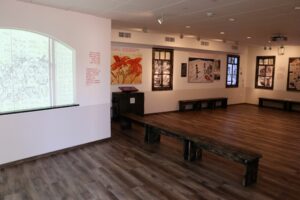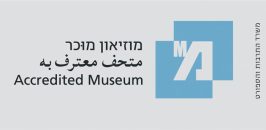MUSEUM
Beit Terezin Exhibitions
Beit Theresienstadt museum exhibits exhibitions that are combined with the educational curricula and offers group instructions on site. Individual visitors can explore the exhibits independently.
 An exhibition based on original exhibits from the ghetto period, and which describes the history of the Theresienstadt Ghetto. The building hosting the exhibition was designed by architect Albin Glaser, who survived the ghetto. Its walls are coated with rectangular red bricks that resemble the walls of the ghetto, forming a 12-side polygon building. The mosaic floor, covering an area of more than 80 square meters, describes the map of the town of Terezin, which became a ghetto during the Second World War.
An exhibition based on original exhibits from the ghetto period, and which describes the history of the Theresienstadt Ghetto. The building hosting the exhibition was designed by architect Albin Glaser, who survived the ghetto. Its walls are coated with rectangular red bricks that resemble the walls of the ghetto, forming a 12-side polygon building. The mosaic floor, covering an area of more than 80 square meters, describes the map of the town of Terezin, which became a ghetto during the Second World War.
The exhibition presents various topics from ghetto life – the Jewish leadership, the transports, daily life and more.
The exhibition’s exhibits include a children’s theater puppet prepared in the ghetto, children’s diaries, paintings by artists, posters of shows and useful daily life objects.
 The exhibition aims to depict the power of cultural life in the Ghetto almost from its establishment until its final days. The exhibition presents artistic and psychological perspectives that allowed the inmates to continue with their lives despite the harsh circumstances of death, hunger, illness, and uncertainty.
The exhibition aims to depict the power of cultural life in the Ghetto almost from its establishment until its final days. The exhibition presents artistic and psychological perspectives that allowed the inmates to continue with their lives despite the harsh circumstances of death, hunger, illness, and uncertainty.
“The walls of the Ghetto that close us physically cannot be destroyed, but the walls that close us spiritually can. An internal reality can be formed with no consideration for the outside conditions, without falling into despair, becoming caught up in the losses of the past or in fears of the future, rather filling life with content”, wrote Zeev Shek, one of the Ghetto’s prisoners.
 The exhibition depicts the world of the children of ghetto Theresienstadt and opens with a “window to the ghetto” that presents everyday life through the paintings of a 12 year old girl, Helga Weiss. Helga describes the transports that arrive, the lines for food, the hospital room and other episodes.
The exhibition depicts the world of the children of ghetto Theresienstadt and opens with a “window to the ghetto” that presents everyday life through the paintings of a 12 year old girl, Helga Weiss. Helga describes the transports that arrive, the lines for food, the hospital room and other episodes.
In front of the entrance there’s the residential building model, built by Georg Lauscher, a survivor of the ghetto who contributed greatly to the establishment of the archive at Beit Theresienstadt.
The viewer learns about the children’s thoughts, fears and distress through drawings, letter quotations, diaries and essays. Video clips screened on a monitor show survivors telling their personal experiences from that period.
The amazing educational project that took place in the ghetto is presented through four educating figures. Since teaching children was forbidden by the Germans, the educational activity in the ghetto was based mainly on various kinds of art, with an emphasis on moral values, mutual aid, Judaism and Zionism. The exhibition features children’s works, as well as the Brundibar opera, in which many children participated.
A wooden relief engraved with the caption “Returning to the Land of Our Fathers” is the exhibit that completes the exhibition, while expressing the hope and continuity of the establishment of the State of Israel
 Beit Theresienstadt’s review and library room presents a modest exhibition relating to music in the ghetto. A few of the composers and performers in the ghetto, such as Victor Ullmann, Hans Krása, Karel Švenk, Rafael Schächter and Gideon Klein, are presented in the exhibition. In addition the exhibition also includes items from Beit Theresienstadt archive relating to music in the ghetto, such as music sheets and posters.
Beit Theresienstadt’s review and library room presents a modest exhibition relating to music in the ghetto. A few of the composers and performers in the ghetto, such as Victor Ullmann, Hans Krása, Karel Švenk, Rafael Schächter and Gideon Klein, are presented in the exhibition. In addition the exhibition also includes items from Beit Theresienstadt archive relating to music in the ghetto, such as music sheets and posters.
The room hosts a piano donated by the late Hanan Bachrich, survivor of the ghetto, and a multimedia system for displaying and playing the digital material collected in the archive.
The Theresienstadt League Sports, racism, and the human spirit
Commemorates the soccer league that operated in the Theresienstadt Ghetto for 3 years. The players were both adults and teenagers. The exhibit introduces visitors to the characters and worldviews of the players and organizers of sports in the ghetto, who utilized sports to instill educational values and to maintain sanity and a connection with the lost world.
Exhibition on music in the ghetto
Central European Jewry, deported to the Theresienstadt Ghetto from 1941-1945, brought its culture with it. It did not take long for the Germans to understand that the inmates’ artistic skills could be used for propaganda purposes. Thus, the German Command permitted them to maintain a cultural life in the ghetto. Absurdly, concerts, operas, and even jazz shows were staged amid circumstances of terrible crowding, hunger, sickness, and death.
Art and medicine in the Theresienstadt Ghetto
The drawings in the exhibition are only some of the many drawings created by doctors and nurses, as well as by other artists who drew doctors’ portraits and various depictions of healthcare services in the ghetto. The purpose of the exhibit is to honor the hundreds of doctors who attempted to practice medicine in such harsh circumstances. Most were subsequently sent from the Theresienstadt Ghetto to the death camps, where they were murdered.
The brown cardboard file
A homage to Felix Bloch. He was a graphic designer by profession who, using impressive sketching techniques, provided a symbolical description and illustrated testimony depicting the chaotic life events within the walls of the ghetto. He created his art on a cardboard file. His drawings portray the city of Theresienstadt: the church and city walls, as well as various “scenes” from everyday life in the ghetto: the arrival of a transport, the yellow star, the city walls, housing in the ghetto, the bunks, work, crowding, illness, food distribution, the elderly in the ghetto, and more. Artists from Israel and abroad employed the language of art, on brown cardboard files, to create a homage to artist Felix Block, using varied techniques and different original styles.
“Varicolored memories from the darkness”
An illustrated testimony by Alfred Kantor. The exhibition is based on The Book of Alfred Kantor, an illustrated testimony born of the artist’s efforts to preserve the events that occurred to him and to those who shared his fate during the Holocaust.
The ability to draw was for Kantor a powerful tool of survival that saved his life. At the height of the tribulations and terror he felt that he could no longer understand the reality around him and function within it. Drawing revived his sense of control over his life. As a creative artist he placed himself in the role of observer, one who watches and documents. He drew in order to explore all the details and memorize them. He was unable to keep his drawings. The source, which was the most important, was engraved upon his memory while creating his art. He drew to ensure that no detail would ever be forgotten by him. In his drawings he expressed the harsh absurd reality that surrounded him in the Theresienstadt Ghetto and in Auschwitz-Birkenau.
A short time after liberation, he reconstituted from memory his wartime drawings and redrew them. To supplement the drawings and to convey the entire truth to viewers he added short titles on the drawings and beside them.
“Limits of the line”
An exhibition of Alisa Ehrmann Shek’s sketches. Focuses on the female figure and on the intimate life of each figure, while emphasizing the flow of the line that captures a concrete action or movement in its entirety and creates strong feelings. Using a brush, marker, or pencil, a visual text is written that expresses in personal language the personal history of the figure. Alisa Ehrmann Shek depicts women tenderly in her sketches. With clear expressive lines she strokes the figure described, even when reflecting a somber mood. Fate was not kind to Alisa Ehrmann Shek and, as a Czech citizen of Jewish descent, she was sent to the Theresienstadt Ghetto where she was liberated nearly two years later. Unlike many others she did not choose to document the “horror”, but her works can be seen as an essentially different testimonial instrument.
1942-1945 “Drawing on the pages of time”
The exhibition consists of the works of Gertruda [Truda] and Emanuel [Emo] Groag and their son Wilhelm [Willy]. The three arrived at the Theresienstadt Ghetto in July 1942 and were liberated in May 1945. The family was deported to Theresienstadt from the city of Olomouc, Moravia. With them came Miriam [Madela] Groag Stein, Willy’s wife whom he had recently married. The exhibition includes a small number of works from the Groag collection in the name of Ida and Heinz Fleischmann that contains hundreds of items: drawings, writings, and objects. The collection was donated to the Beit Theresienstadt Archive by the family.
Side by side with the work duties of the inmates the Groags, similar to other artists among the inmates of the Theresienstadt Ghetto, did not cease their creative efforts. Throughout their time at the ghetto – amid hunger and sickness, hardship and despair – they continued to write and rhyme, draw, illustrate, and sing.
The color drawings and the black and white sketches are full of optimism. They are all very aesthetic, with attention to the smallest detail. The range of topics is rich and diverse: portraits, Theresienstadt sites, events, nature: flowers, landscapes, trees…, and only a little death.
Whole fragments 2
Jewish Sports before the Holocaust
The exhibition presents the development of Jewish sport before World War II, as part of the daily culture of the Jews of Central Europe. Sport was an important part of the cultural everyday life before the war and was also a part of the cultural activity that existed in the Ghetto.
“Terezin League – Sport and Youth in the Theresienstadt Ghetto”
The exhibition tells the story of different sport activities and the soccer league in particular, which took place in the Ghetto between 1942-1944.
The exhibition includes videos from one of the soccer games, filmed in the Ghetto as part of the Nazi propaganda film, testimonies of Ghetto survivors who played in the Terezin league, pictures and objects related to sports life in the Ghetto, diaries, newspaper and drawings of youth and adults documenting the sport activity and its influence on the youth in the Ghetto.
The exhibition presents the stories of sports educators, among them Stella Hermann and Freddy Hirsch
Newsletter Sign up


